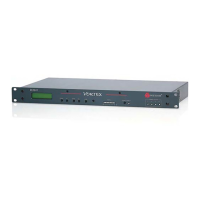This document describes the command protocol that is used to communicate with the Vortex EF2241 via its
RS-232 port.
2. RS-232 Hardware
The communication between the Vortex and a host controller is conducted via the RS-232 port on the back
panel of the Vortex. The Vortex's RS-232 port operates at the following settings:
● Bit Rate (bps): 9600 (default), 19200, or 38400
● Data Format: 8 data bits, no parity, 1 stop bit (8N1)
● Flow Control: none (default) or hardware (RTS, CTS)
Note that although the flow control setting is user selectable to none or hardware, hardware flow control
must be used when updating the firmware of the Vortex. This means that while a 3-wire RS-232 cable (RX,
TX, GND) is acceptable for control of the Vortex, the minimum cable for updating firmware should contain 5
wires (RX, TX, RTS, CTS, GND).
3. Programming Tips
3.1. Initialization
During power up of the Vortex device or initialization of the host program, electrical fluctuations on the RS-
232 lines may cause the Vortex to receive spurious data. After initialization, the host program should send a
few carriage return characters (^M, ASCII 13) to the connected Vortex to flush out any spurious characters it
may have received. Failure to do this could result in the Vortex ignoring the first command received after
initialization.
As part of the host program initialization, the host will want to synchronize the status of its controls with the
current status of the Vortex devices that are being controlled. The host could initialize its controls to default
values and then send commands to the Vortexes to set them to the same state. This approach has significant
disadvantages since initializing the host program could undo settings made by other host programs or by the
front panel controls of one of the linked Vortex devices. A better approach is to query the linked Vortex
devices for their status and set the host program controls based on the return values.
3.2. Wildcard Characters
The use of the wildcard character, '*', can make programming the host controller much easier. Be careful
when using wildcards, however, since they can generate a lot of traffic on the digital bus.
3.3. Using Acknowledgements
It is a good idea for the host program or control system to make sure that all connected Vortex devices have
acknowledgment mode enabled (see the ACKMOD command). When acknowledgment mode is on, a Vortex
device will send an acknowledgment for each command it receives. Proper use of acknowledgments makes
the host program more robust and makes supporting multiple hosts effortless. The rest of this section
describes how to use acknowledgments to achieve these goals.

